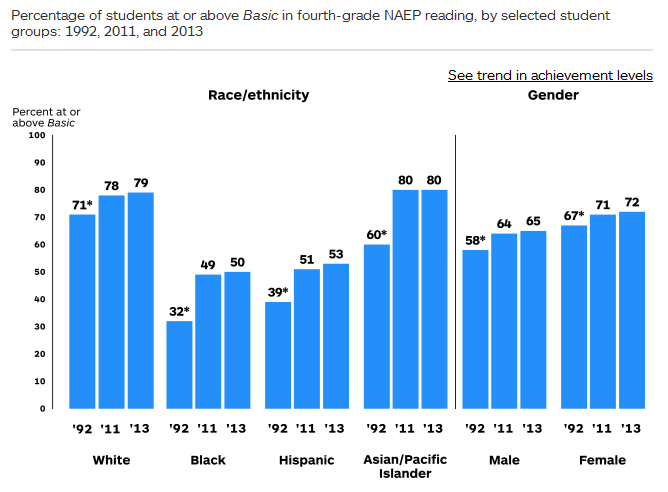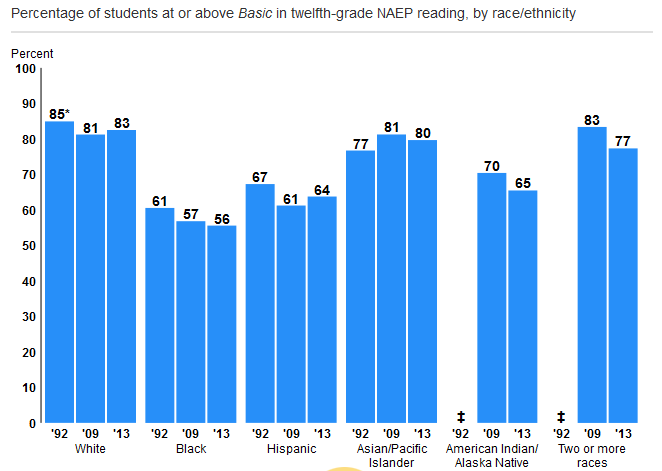
Democrats didn’t have a lot to run on this year. Michael Barone notes they have studiously avoided Obamacare, Ebola, the Islamic State, the stimulus, the Keystone XL Pipeline, and pretty much anything to do with President Obama. So they tried the War on Women. Somewhere between Wendy Davis and Mark Uterus, it backfired.
Their pollsters did come up with something leftist voters responded well to: education; specifically, pumping more of existing workers’ money into ostensibly future workers’ pockets (after filtering through several layers of government bureaucrats). The ways of fueling this vampire blood suck are many: Government childcare and preschool, paying everyone’s college tuition, and increasing K-12 spending. And it’s worked, or at least been something Democrats can talk about without wincing, says Politico:
Political analysts say the focus on education is clearly having an effect, based on the number of Republican candidates scrambling to address the issue when they’d rather be talking about the economy or Obamacare.
It’s even worse than that, from a principled perspective. As Rick Hess and Max Eden write in National Review Online, here’s how Republican candidates have responded:
the only proposal that most Republicans seem to embrace is the notion that the government should spend more money on schools and colleges. Twenty of the 35 Republican gubernatorial candidates tout the increases in school spending they’ve overseen while in office or their promises to boost spending if elected. (Democrats running for governor are actually less likely to brag about their proclivity to spend more, with just 16 doing so.)
Meanwhile, on any subject other than spending, Republicans tend toward silence. Just three of the 35 Republican gubernatorial candidates mention teacher tenure, and just one would-be senator mentions it. Barely a third of prospective GOP governors bother to mention charter schools or school choice, and just four declare that money should follow students to the schools of their parents’ choice. Yet Education Next reported this summer that Americans oppose tenure by a two-to-one margin, and Gallup reports that 70 percent of Americans support charter schools.
For all the grassroots fervor about the Common Core, just ten of 35 GOP gubernatorial candidates mention the issue (nine of the ten oppose it). While 17 would-be senators cite their opposition to the Common Core, the U.S. Senate has little ability to actually do anything on the question — making this a mostly symbolic stance.
As these gentlemen note, when “who will increase education spending more?” is the key criteria Democrat strategists push on voters—and Republicans accept!—it’s only logical for everyone to conclude the answer is “Democrats.” Not exactly a winning platform, GOP. As usual, though, the facts are not on the side of big government. U.S. taxpayers have tripled their education spending in the last 40 years, in inflation-adjusted dollars, and we’re not seeing different outcomes. And most voters think schools spend a third to a half what they really do. When they learn true spending figures, support for increasing spending drops.
Our Current Education Course Is Disastrous
But the raw economics of this is far less important than the demographic trends that will bury us if this nation does not drastically and quickly improve the quality of our K-12 education system. At the same time as our future taxpayers face paying off the largest government debt in the history of humankind, those future taxpayers’ ability to pay it off is declining, because our youth population increasingly comes from demographics we simply do not educate well, if at all. This fall, for the first time, the nation’s K-12 schools were majority minority, and the proportion of minority students (especially Hispanics) is projected to increase.
How badly do U.S. schools educate black and Hispanic children? Let’s look at just a few screenshots from the last round of national tests (which, by the way, this year were arranged in a far more deceptive way so that it’s harder to find these comparisons). I’m going to use reading scores, since those correlate with a host of measures that indicate future economic and personal success. Here’s the latest fourth-grade results, by race.
 Just to be clear: half of black and Hispanic kids score below basic in reading in fourth grade. This essentially means they are functionally illiterate at age 8 or 9. Education results for black and Hispanic kids in the United States are closer to those of kids in Mexico, which spends a relative pittance on education, besides other social problems. And here are the twelfth-grade results in reading, so you can see what near-graduates look like. This is the kids who have managed to stay in school, because one in seven Hispanic students drops out, and nearly one in ten black students drops out. Again, to get the number of functional illiterates, you have to count what you’re not seeing, or 100 minus the percentage here. So this shows 44 percent of black twelfth graders and 36 percent of Hispanic twelfth graders have trouble reading basic English. Note also that the latest scores are worse than 20 years ago.
Just to be clear: half of black and Hispanic kids score below basic in reading in fourth grade. This essentially means they are functionally illiterate at age 8 or 9. Education results for black and Hispanic kids in the United States are closer to those of kids in Mexico, which spends a relative pittance on education, besides other social problems. And here are the twelfth-grade results in reading, so you can see what near-graduates look like. This is the kids who have managed to stay in school, because one in seven Hispanic students drops out, and nearly one in ten black students drops out. Again, to get the number of functional illiterates, you have to count what you’re not seeing, or 100 minus the percentage here. So this shows 44 percent of black twelfth graders and 36 percent of Hispanic twelfth graders have trouble reading basic English. Note also that the latest scores are worse than 20 years ago.
 Do I really need to point out that children who can hardly read also can hardly contribute to the economy beyond entry-level labor-type jobs? “But that is not all. Oh, no. That is not all.” Not only must these worse-prepared children deal with the worst government debt in history, they must also deal with perhaps the worst-arranged distribution of government funds in history: An increase in the medical and other costs that taxpayers largely shoulder on behalf of old people, just as the proportion of elderly is also predicted to rise.
Do I really need to point out that children who can hardly read also can hardly contribute to the economy beyond entry-level labor-type jobs? “But that is not all. Oh, no. That is not all.” Not only must these worse-prepared children deal with the worst government debt in history, they must also deal with perhaps the worst-arranged distribution of government funds in history: An increase in the medical and other costs that taxpayers largely shoulder on behalf of old people, just as the proportion of elderly is also predicted to rise.
Mismatching Poor Kids Will Make This Worse
This is a recipe for social warfare and instability that is nothing like the fabled war on women. Old people vote. Children do not. Here’s the leftist answer to this death cluster, as reported by National Journal. In a word, it’s mismatch. Here’s what Catherine Lhamon, assistant secretary for Civil Rights at the U.S. Education Department, thinks is the answer:
Although white students in Des Moines schools account for just under half of enrollment, the OCR reports they are disproportionately overrepresented in gifted programs and in advanced classes such as algebra, calculus, and chemistry, and underrepresented in counts of suspensions and expulsions.
‘That is consistent nationally, but it’s very disturbing to me,’ Lhamon said. ‘What we’re saying is that we are reserving our expectations for our highest rigor of courses…for a class of kids who are white and who are wealthier…’
Lhamon and her office are pushing schools and districts to expand access to and increase expectations for all students, no matter their socioeconomic background, ethnicity, or race.
We have already tried larger-scale applications of affirmative action in college. Research now shows that, rather than increasing minority kids’ life chances, it retards their progress further. This is because of what researchers call “mismatch“: An average-scoring kid who gets accepted to a high-level college will quickly feel underwater because he cannot keep up. So he either drops out or down-shifts into a less difficult, “soft” course of study such as sociology. (By the way, such arrangements also perpetuate racial stereotypes.) If the kid had attended an institution that aims its classes right at his ability level, he is more likely to get a diploma and pursue harder, more financially and socially rewarding careers and majors such as biology or finance.
Likewise, taking a child with poor academic preparation and putting him into honors classes just to gin numbers is likely to harm him further. What he needs is both better academic preparation early on and to be placed into classes that fit his ability level—just as Des Moines was doing before the federal micromanagers got involved.
A Texas Case Study of Dangerous, Accelerating Education Inequality
Minority kids who will soon shoulder America’s debt and welfare bomb need much more than that, however. The situation is so dire it requires all hands on deck, not tweaks around the edges. Researcher Matthew Ladner has been investigating and discussing this very problem now for several months, both as it exists nationally and in several selected states. Texas is seeing explosive growth in K-12 students, as families are migrating there for economic opportunity from both inside the United States and without. Because of its size, Texas enrolls as many students as about the smallest 20 states combined. Just Hispanic students are half those enrolled in Texas schools. Add blacks, and the “minority” enrollment becomes 63 percent. Their academic outcomes are no better than their peers nationwide—which is to say, awful. The latest SAT results in math show Texas at the lowest point in 22 years—even lower than California, which has similar demographics. Ladner writes:
By educating only a small cadre of students to participate and prosper in the global economy, the future of the state will begin to look like that of Brazil in the late 20th Century, which one of my professors once described to me as ‘Belgium floating on top of India.’
As a purely economic matter, Texas can continue to import college educated workers from the less dynamic states indefinitely. As a matter of socio-economics however one cannot avoid asking fundamental questions regarding the long-term stability of both the prosperity and even democracy itself. A public education system with only 17% of Hispanics and 15% of Black students reading proficiently constitutes a foundation of sand for the opportunity society needed to secure the future.
I realize politicos don’t give a damn about creating an opportunity society, or about serving the needs of the least among us. But they do care about votes. And if these kids don’t receive the foundation they need for economic self sufficiency, the Texas education problem looks likely to become a Texas electoral problem, in which case Republicans can kiss the presidency goodbye forever. Here’s Ladner again: “In 2012, Texas Hispanics comprised 25 percent of the electorate and favored Barack Obama over Mitt Romney by a margin of 62% to 37%. That’s a more balanced result than the national numbers, but hardly reassuring if you are a Texas Republican. Each passing year will see older Republicans passing on, and more young Hispanic voters entering the electorate.”
Look: Hispanic and black children need to read, write, compute, and understand our unique form of government, just as all children in this country do, in order for this nation to survive. That is simply not happening in government schools, and it hasn’t been for at least 50 years. You know where it does happen? In private schools.









